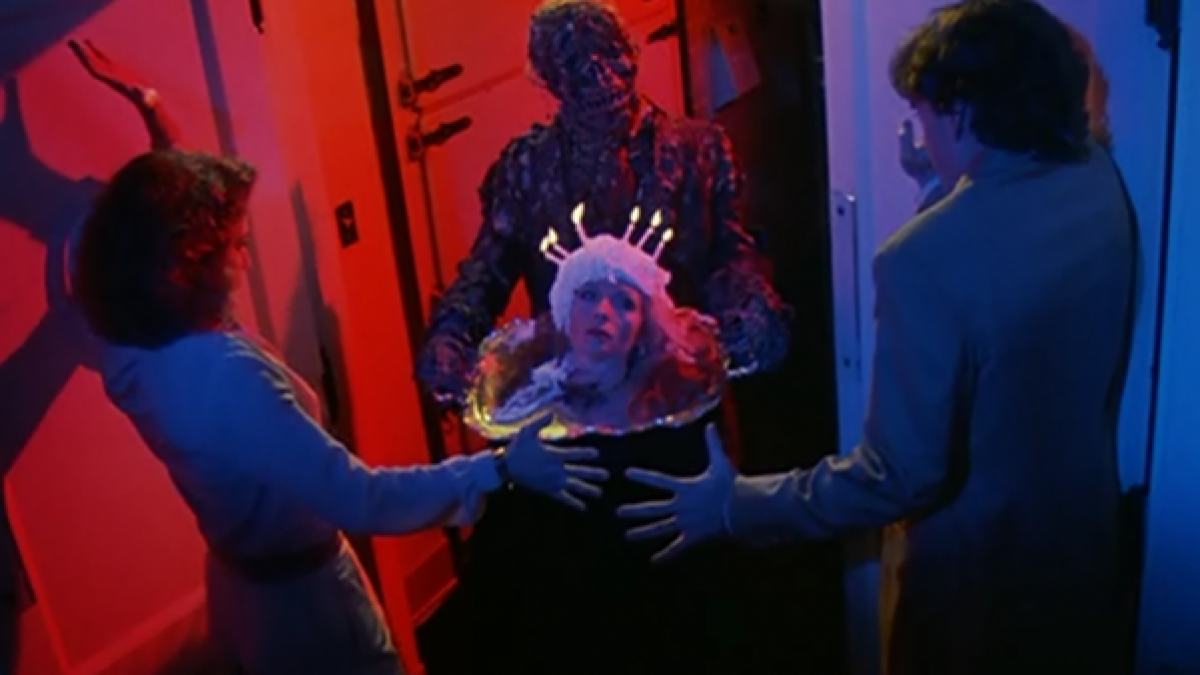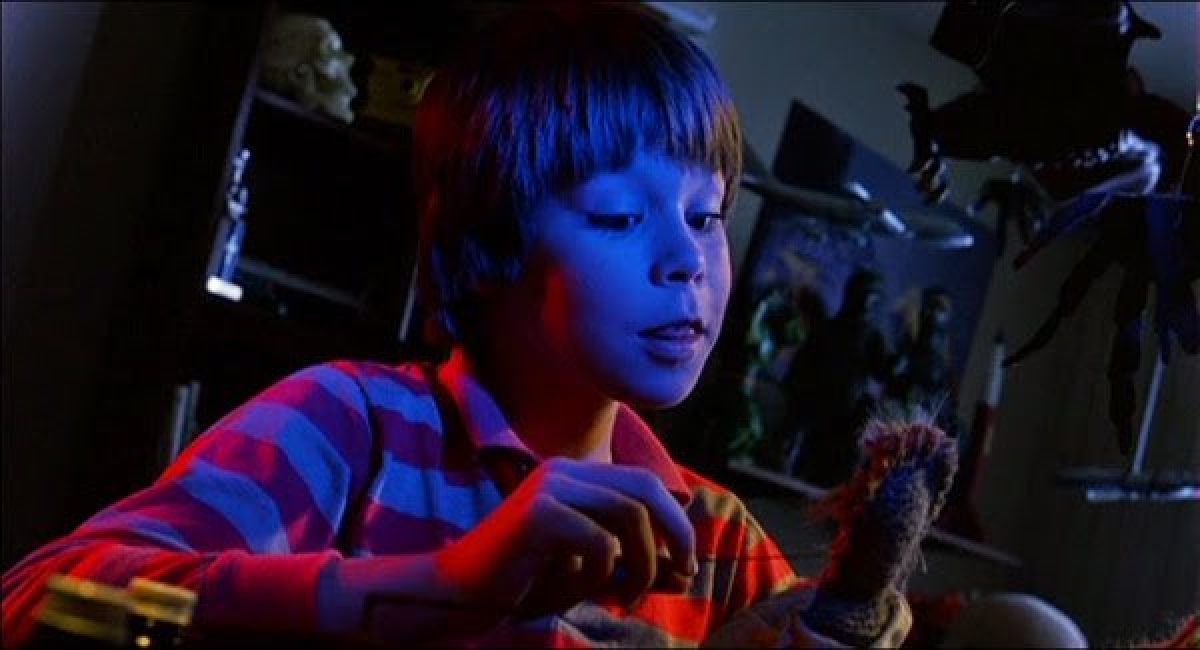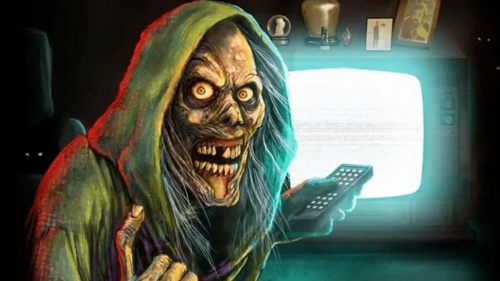A Moral Comic: CREEPSHOW At 35
George A. Romero initially hooked up with Stephen King after showing Martin (’78) at the US/Utah Film Festival (which would later morph into the Sundance Film Festival), when two studio executives approached him, saying the writer/director would be perfect to helm a new property they’d just acquired from the up-and-coming horror author. The book they’d bought the rights to was Salem’s Lot – a New England vampire spook show that eventually became a stellar two-part CBS Movie of the Week under Texas Chain Saw Massacre (’74) director Tobe Hooper (Romero exited the project just before it headed to TV). However, because of a meeting the suits had set, a friendship had been kindled, as the two scare masters shared a love of cinema (with King professing to be a huge fan of Night of the Living Dead [‘68]) and macabre storytelling.
The movie Romero really wanted to direct was The Stand – King’s post-apocalyptic American epic that could’ve never been financed under a major studio (despite Dawn of the Dead [‘78] dealing with similar End Time themes). However, the Pittsburgh auteur had an idea for an anthology that could trace the history of horror pictures, complete with aspect ratio and film stock changes. Each vignette would be set in a different era; from a Val Lewton inspired B&W chiller, to the in-theater gimmicks of William Castle, to a 3D segment meant to cap the entire affair. Instead, King suggested to both Romero and his longtime producing partner Richard P. Rubinstein that they should craft a tribute to the old EC Comics each had grown up reading as children. Romero and Rubinstein were bowled over by the pitch, and King promised them a script within sixty days, which he delivered right on time.
The end result was Creepshow (’82) – a collection of five stories King had either published before (The Lonesome Death of Jordy Verrill*) or penned just for the picture (Something To Tide You Over); each meant to play on both the jokey gore and ethical dilemmas that usually made up the issues of those filthy funnies. King even had t-shirts printed with the slogan “A Laurel Comic is a Moral Comic”; a catchy play on the company Romero and Rubinstein had started together (Laurel Entertainment), and the principled twists that usually capped each book in a funny fashion. The project was shopped to several studios, but was ultimately rejected and picked up by Salah M. Hassanein’s United Film Distribution Company as part of a three-picture deal (which came with the stipulation that one of the trio had to be a third Dead film). With a budget of $8 million, Romero set about casting the movie with the biggest allotment of his career, causing him to be slightly intimidated by the project.
Shot in his Pittsburgh and Monroeville, Pennsylvania stomping grounds, Creepshow remained a tight-knit production, with many of the same crew and actors who’d helped Romero craft his previous DIY masterworks onboard. Dawn SFX guru Tom Savini (fresh from blowing minds and heads clean off with Friday the 13th [‘80], Maniac [’80], and The Burning [‘81]) oversaw the numerous goopy prosthetic effects, while Swamp Thing co-creator Bernie Wrightson illustrated the animated book that contained each of the shocking shorts. The wrap-around story made Creepshow a literal family affair, as it involved a young boy (King’s own son, Joe [Hill]) being punished by his abusive father (Tom Atkins) after he discovers the eponymous comic in the kid’s room. “That’s why God made fathers, babe,” the proud papa says after slapping his son and tossing the issue in the trash, not knowing that an evil specter is waiting outside the boy’s window, letting him know that he’ll get his revenge shortly after these five stories are spun…

Father's Day
If anything, Creepshow’s opening segment is a rather comforting piece of familiarity from Romero, as it retools his favorite undead ghoul into a vengeance-seeking dessert enthusiast from beyond, shuffling about to take revenge on the ungrateful brood who put him six feet deep. Only instead of screaming about “brains” (as previous collaborator John A. Russo would have his own pseudo-sequel zombies do in Return of the Living Dead [‘85]) this ugly, smelly creature is craving the cake he never got on his final living Father’s Day. It’s Romero and King paying tribute to those thin, pulpy pages that used to sit next to men’s magazines in the drugstores they frequented as kids, filtered through each’s sly, comedic lenses.
Despite all the bright colors and eye-popping panel-like transitions that announce just how goofily garish this entire endeavor is going to be, the other element of Father’s Day that instantly grabs the audience’s attention (especially if viewers are familiar with Romero’s previous work) is the rather attractive cast. Ed Harris (Knightriders [‘81]) dances his way into an early grave, while Viveca Lindfors (The Way We Were [‘73]) provides a layer of classiness, despite her gothic get up and constant cigarette smoking. In order to elevate the material and show just how passionate he was about the project (as a work of reverence to both King and EC kingpin William Gaines), Romero populated roles with faces he thought were authentically “serious”. The gamble pays off in a big way throughout the whole of Creepshow, as the audience can practically feel the Pittsburgh auteur balancing several tones and intentions simultaneously, creating a fluid work of pop art.

The Lonesome Death of Jordy Verrill
“Just act like Wil E. Coyote as he’s going over a cliff.” This was the direction Romero gave to Stephen King, after he cast the writer in the titular role of the second segment. The Lonesome Death of Jordy Verrill is often viewed by many fans to be one of the weaker (if not weakest) Creepshow installments, but that line of thinking discounts just how much fun King is having onscreen. Jordy runs around his farm like the aforementioned animation character, swearing about “meteor shit” after finding a crashed comet in the field behind his ranch. Only, while the overall-donning peckerwood keeps daydreaming about how much money the local university is going to give him for such a monumental discovery, strange green growths keep sprouting up across the estate, and then on Verrill himself. It’s a creeping death that brings an odd ominousness to the vignette, as we sense any chance for escape evaporating with each passing second.
Sure, King’s performance is riotously over the top, full of obnoxious mugging and a “daw shucks” accent that renders his loudest attempts at rural characterization on the page subtle by comparison. But by the end of The Lonesome Death of Jordy Verrill, the melancholy of what it means to expire in an empty home becomes overwhelming. If you remove all the purposefully cartoonish histrionics and genre elements, rendering it a short movie about a man dying in a cabin of a more natural cause (say, cancer), then the second Creepshow yarn is actually perfect in its representation of slowly rotting away, and the grim recognition that these few hours are actually your last on the planet.

Something To Tide You Over
Written specifically for Creepshow, this second of two zombie entries is notable for featuring Leslie Nielsen (who apparently carried a fart machine around with him on set), and a pre-Cheers Ted Danson (who was unsure whether or not his new show was going to survive past its initial season), and Gaylen Ross (Dawn of the Dead). Nielsen is a jealous husband, who discovers that his wife (Ross) is cheating on him with her handsome new beau (Danson). Despite the undead story twist, Something to Tide You Over is the most human of the five tales, as we genuinely feel for the lovers, who are doomed to be buried alive, their tragic demises videotaped for the possessive ex's amusement.
King's difficulties with exposition mark Something to Tide You Over as the sluggish mid-point of the movie. Had the segment been placed earlier, these dialogue dumps may have been slightly easier to get through. Perhaps the sequencing was a conscious decision on the writer’s part; an attempt to slow the storytelling down and let us really hang out with this crafty revenge plot. It’s not necessarily a bad segment, and the giftedly endearing turns by Danson and Nielsen are certainly welcome. It’s just oddly placed within the whole, as a quicker paced story may have helped move the movie along a little better.

The Crate
The Crate has always been this writer’s favorite Creepshow segment – a monster movie in which a meek college professor (Hal Holbrook) has finally had enough of his obnoxious, overbearing wife (Adrienne Barbeau) and decides to feed her to a Yeti-like creature. Originally appearing in the July ’79 issue of Gallery, The Crate is arguably the least like an EC Comics tale, playing much more like a straight-ahead creature feature, in which the flesh-feasting beast is discovered in a chained wooden box beneath one of Horlicks University’s staircases.
Out of the all the segments, The Crate is where Tom Savini is really allowed to run wild, as the abominable ape-beast (known as “Fluffy”) is the perfect combination of totally ridiculous and utterly terrifying, becoming the instrument of the overrun husband’s revenge. Whenever it attacks, faces are mauled and blood pools on the dark grey concrete of the lowest level’s floor, the creature making a feeding cave out of the under-lit well. It’s a marvelous creation, and one of the greatest tricks ever concocted by one of cinema’s greatest magicians.

They're Creeping Up On You
Leave it to the final segment of this two-hour collection to really resemble the socially conscious horror Romero made his name on. Upson Pratt (E.G. Marshall) is a cruel, ruthless businessman whose mysophobia has him living in a hermetically sealed (and blindingly white) apartment, but finds himself helpless when his isolated paradise becomes overrun by a seemingly endless throng of cockroaches. No matter how much bug spray he unleashes on the crawlies, they keep coming back, as if determined to penetrate his perfect, self-made prison.
Just like his earliest zombie work, They’re Creeping Up On You is a sly commentary on race in America, as Pratt has no problem slinging racial slurs; the whiteness of his domicile standing in stark contrast to the blackness of the city below. He’s a cruel man who’s made his living off of exploiting the poor, and now his own prejudices have manifested themselves in the form of an all-consuming horde. The final moments of this ultimate segment are truly disgusting, as the man’s body is eaten from the inside by the infestation; a destructive manifestation of his own ingrained hatred and distrust of those he deems to be nothing more than vermin.

As fun as Creepshow is, the movie Romero and King crafted is also an act of revenge, as each has recounted in interviews how the EC titles the movie is paying tribute to were frowned upon by many in mainstream society, and that the filmmakers' own parents often disallowed them from reading the books' gore-filled pages. So, when Joe Hill's scorned little boy starts sticking pins into the voodoo doll he ordered from the magazine's carnival-barker ads, causing his father to writhe and choke downstairs (all while John Harrison's piano and synth score blares), it could be interpreted as Creepshow's creators having a laugh at the expense of all those who told them that horror was nothing more than lurid trash. In reality, these colorful campfire tales were silly parables, beamed through a psychedelic prism of grimy pulp. Romero had made an entire career using his monsters to comment on the human condition, and now (with the help of King), he was poking fun at those who looked down on horror in general, simultaneously minting a classic that's yet to be matched.
*First printed in Cavalier in May ’76.



